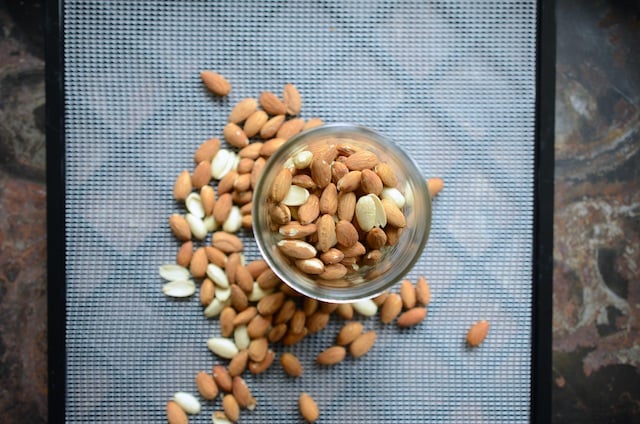
Dehydration has long been one of the tools in my food preservation toolbox. I like to dehydrate herbs and ramp leaves, make tasty marinated and dried tomatoes, and put up some of my precious Meyer lemons by drying slices for future rehydration.
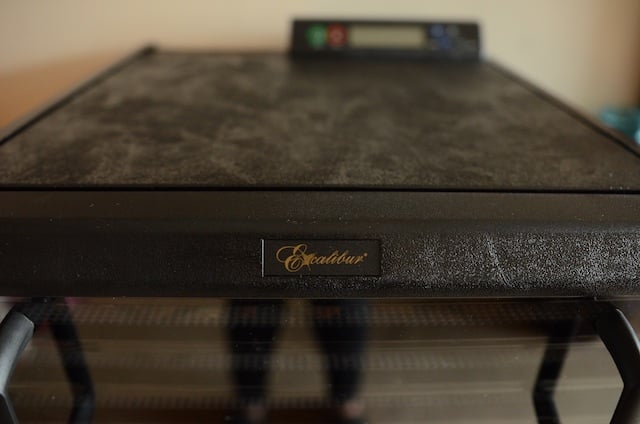
Recently, my dehydration game improved by several notches. The folks at Excalibur sent me one of their 5-tray dehydrators. It’s a huge step up from the stackable models I’ve used for so long. I’m totally delighted by it and have spent the last few weeks drying all the things.
It’s got five large trays that slide in and out (meaning no more working around a central column!) and that add up to a total of eight square feet in drying space. It has a digital control panel that allows me to set both the precise temperature (between 95◦F to 165◦F) and the duration of the drying session. And it’s relatively quiet (as far as dehydrators go, at least).
Truly, the only issue I have with it is that it’s kind of a beast in terms of its footprint. I don’t mind that, but it does mean that I’ve had to start running it in my living room, because it doesn’t fit comfortably in my kitchen. However, it’s a trade-off I’m very happy to make.
One of the first things I made with my fancy new Excalibur was a batch of sprouted almonds. I first tasted such a thing six years ago when I was staying with my sister in Texas and we were waiting for her first baby to be born. We were doing laundry at her friend’s house and while we waiting, she headed for their pantry and brought out a jar of almonds.
Different from almonds I’d eaten, these were crunchy and hollow on the inside. Raina explained that they were sprouted (and were wickedly expensive at their local co-op). I hurried to put the jar away before we ate all of them and filed the idea away to try and make them myself someday.
Fast forward six years and they’re a regular homemade favorite. They’re not hard to make (and truly, can be done even if you don’t have an dehydrator. But they’re better and easier this way because you can set them up and forget them for most of a day) and are so very delicious. You start by combining one tablespoon of salt with four cups of warm water and letting the salt dissolve.
Then you add two cups of raw almonds and let them soak overnight (don’t let them soak more than about 12 hours. After that, they start to ferment and get a little sour). The next day, you drain the almonds and arrange them on a dehydrator tray. Then you set it to 150◦F and let them do for 12-24 hours, until the almonds are completely dry. Once they’re dry, you funnel them into a jar and snack away.
Now, soaking and dehydrating almonds does also have the added benefit of making the almonds more nutritious and easily digested. But my primary motivation is the fact that it makes them so delicious.
Next week, I’m going to show you guys how I soak, sprout, dehydrate, and grind wheatberries into flour! But for now, I’d love to hear about your dehydrating experiences! Do you have one? What’s your favorite thing to make in it?
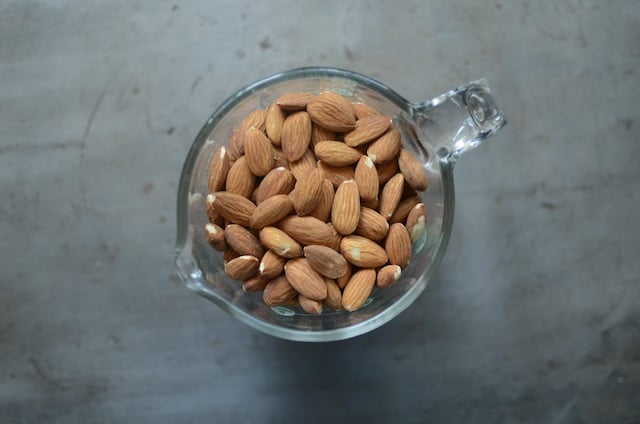




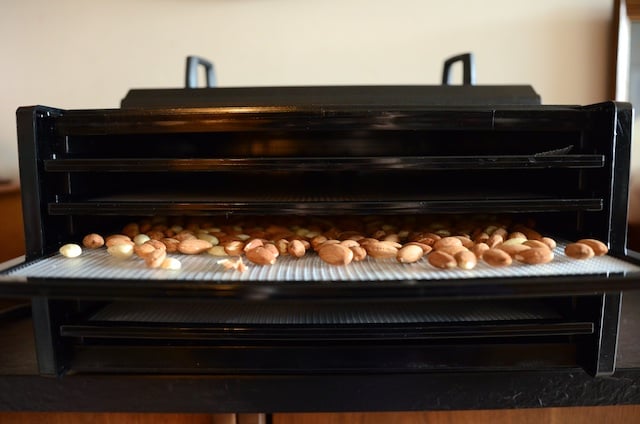

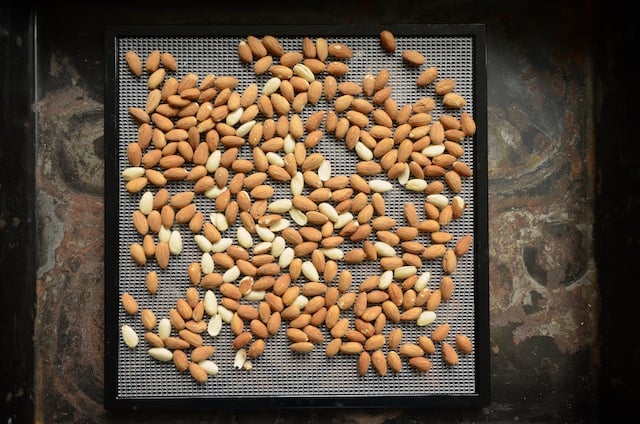

Before it occurred to me that I could soak (even sprout!) and dehydrate my “natural” almonds with the skin on I BLANCHED them (soaked in boiling water for two minutes, then removed the skins).
Making almond butter with some of the blanched almonds was a disaster, it was more like marzipan.
Then I dehydrated blanched almonds in my Excalibur but suspect I’ll have the same result so this go-round I’ll also toast them.
There is NOTHING on the internet about dehydrating blanched (skinless) almonds.
Does anyone have an opinion on this? Is blanching a pointless and unnecessary step if one is planning to soak, perhaps sprout, and definitely dehydrate?
Can you set your Ex. dehydrator somewhere between 105-115 to make them sprouted Raw almonds? If so, how long do you think it would take them to dehydrate at that low temp? Thanks!
My husband gave me the Exacalibur for Valentine’s Day a few years ago. He’s very romantic. 🙂
My favorites: kimchi dried and ground to use as a spice; fruit leather from wild berries and feral apples; wild mushrooms!!!!
Love, love , love me some dehydrator! We lucked out and found a great deal on a “small” 12-tray commercial variety compete with glass door. It is spectacular. Also got the mats and fine mesh liners. Those really help out for small pieces being dehydrated.
Have tried all sorts of things but perhaps the most useful is simply catching frozen veg on sale and running it though the dehydrator. Already treated with ascorbic acid, so just dump and run. Easy to dehydrate and easy to add to soups and stews. AND, no additional cost for storage.
Still use the old, round dehydrators for drying chiles outside. Don’t want to take a chance with the fumes inside the house.
Yessss Excalibur! I have the 9-tray version and I love it – I never knew about this use though. Very cool!
Would this same technique work with other nuts? We farm Hazelnuts (filberts), so despite having a abundance of recipes featuring them, I’m always looking for more ways to use them. 😉 Thank you!
I’ve not tried it, but I believe so.
I use my Excalibur to make, among lots of things, crackers from the pulp we generate from making almond milk. I save the pulp from several batches of almond milk in the freezer. When there’s a bunch I thaw it and add spices, ground flax seed, nutritional yeast a little oil and tamari. Flatten onto the Teflex sheets amount 1/8 ‘ thick, score it in cracker squares and dehydrate. Flip straight onto the net sheets after a couple hours to finish and allow extra circulation for crispy crackers!
Hello Marisa,
The sprouted almonds sound great! I don’t have a dehydrator – it’s in the “maybe buy someday” list but that’s a looong list. You mentioned that you didn’t need a dehydrator though it was easier to do it that way. Could you make these in the oven? My oven’s lowest temperature is 170. Should I just check them sooner than 12 hours, and would I need to stir the nuts if done in the oven?
Yes, you can do in your 170F oven. Just check more often and give them a shake on occasion.
I absolutely LOVE my Excaliber! Congrats on the gift. You will have many years of enjoyment from this quality machine. I will certainly try these almonds and I look forward to your method of sprouting, drying and grinding flour as well. I found a wonderful electric mill in the barn that has 3 or 4 levels of grinding coarseness.
I am interested in the sprouting process but I have not delved too deeply into trying much more than some seeds for salads and sammies.
I cannot wait to try these almonds! Two questions – what are your thoughts on then using them in a batch of granola, and I have a dehydrator that cannot be set for temperature. (I think it’s around 160?) Can I make the almonds in that and what should I keep an eye out for?
I think they’d be delicious in a batch of granola. And if you can’t adjust your dehydrator, you will probably need to run them for a shorter period of time. Taste one after 12 hours and see if it feels dry all the way through.
I have had my eye on an Excalibur for several years now, but can’t seem to find the funds just yet.
For now, I have been using a 15 year old Aroma dehydrator, mostly to dry basil, as basil needs to be dried more quickly than other herbs.
Recently, I have been using it to dry tomatoes in the summer. I usually blanch and peel first, as I think the product tastes better without the skins. Then I cut in half, squeeze out the seeds and juice, and let them dehydrate. Usually takes more than a day to get it right, but they do taste fantastic.
Someday, the Excalibur will be a reality, and I will do more ambitious things such a jerky, which will cause my plastic grids to crack on the Aroma.
My neighbor and canning partner bought a dehydrator over the winter – I can’t wait to try some dried cherries, which I love. Cherry season is still a month or so away here, but not too early to be thinking about it.
I love my Excalibur. I’ve made fruit leather, fruit-&-yogurt leather, jerky, dried orange slices, dried citrus peel, dried herbs of all sorts, dried mushrooms (some of which stayed whole, some of which became mushroom powder), dried chilies (some of which stayed whole, some of which became chili powder), yogurt, dried bananas and apples and pears and pineapple (sometimes plain, sometimes with various spices on it), dried cherry tomatoes and roma tomato quarters, dried tomato skins that became tomato powder, dried pumpkin puree that became pumpkin powder (great over oatmeal or vanilla custard & ice cream), and we’ve dried our homegrown pot flowers in it.
I should try making a dehydrated veg soup mix, drying some soup base into cubes, and maybe drying some tomato paste for powder.
Thanks for this new idea for my dehydrator I am going to try it this weekend!
I love my excalibur! It was a nail biter to spend so much money but wow have we used it for years on so many things. My hands down favorite thing is pineapple. I peel it, slice it with a meat slicer (for perfectly even thickness slices) and use a little round cookie cutter to cut out the core. So delicious dehydrated!